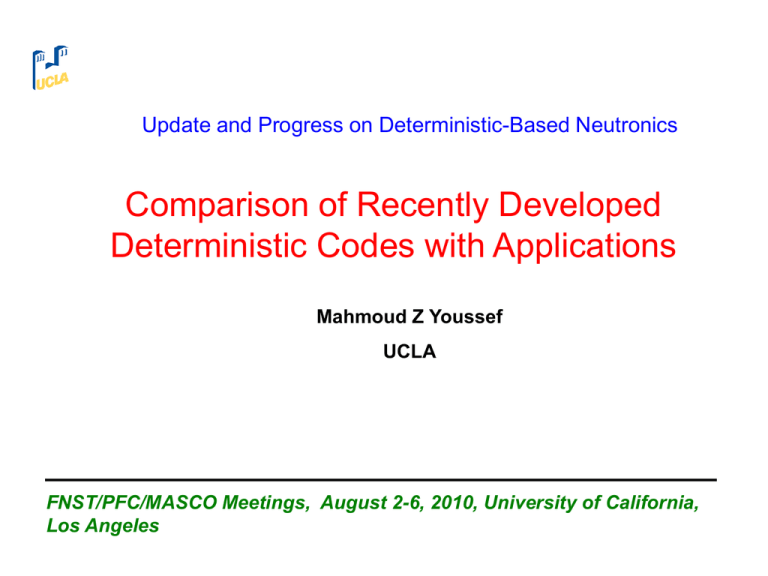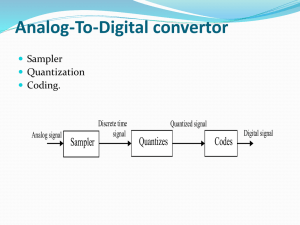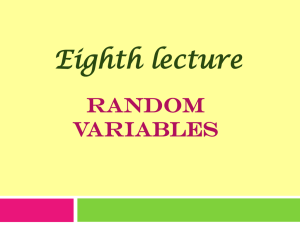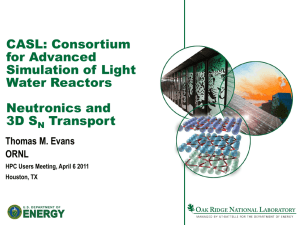Update and progress on deterministic based neutronics
advertisement

Update and Progress on Deterministic-Based Neutronics Comparison of Recently Developed Deterministic Codes with Applications Mahmoud Z Youssef UCLA FNST/PFC/MASCO Meetings, August 2-6, 2010, University of California, Los Angeles Outlines -Backgroud information - Method of Discrete Ordinates (discretization in energy, angle and space) - History of of issuance of deterministic codes -Recently developed deterministic codes and comparison - Denovo - PARTISN - ATTILA -Applications (Capabilities and Limitations) – Emphasize on Attila -Comments Calculation Methods for Neutron and Photon Transport The methods can be broken down into two broad groups Deterministic method: Directly solves the equation using numerical techniques for solving a system of ordinary and partial differential equations Monte Carlo method: Solves the equation using probabilistic and statistical techniques (Stochastic Approach) Each method has its strengths and weaknesses Deterministic Method: Linear Boltzmann Transport Equation (LBTE) ˆ t Qscat Qext streaming collision where, sources ˆ r, E E , ˆ ˆ Q scat dE d s 0 4 • Represents a particle balance over a differential control volume: – Streaming + Collision = Scattering Source + Fixed Source – No particles lost Angular Discretization • Angular Differencing – Discrete Ordinates (SN) – Solves the transport equation by sweeping the mesh on discrete angles defined by a quadrature set which integrates the scattering source – Sweeps the mesh for each angle in the quadrature set 0.5 cm Element Size Ωi SN=Quadrature set of order N Number of angles in level-symmetric set= N(N+2) Abdou Lecture 5 Scattering Source Expansion • Scattering cross section is represented by expansion in Legendre Polynomials ˆ ˆ 2 r, E E P s r , E E, s , 0 0 4 • The angular flux appearing in the scattering source is expanded in Spherical Harmonics ˆ ˆ r, , E m r , EYm 0 m Flux moments Spherical Harmonics • The degree of the expansion of the resulting scattering source is referred to as the PN expansion order scat g Q Abdou Lecture 5 L G ˆ ˆ r , s ,l , g g r m, g Ym 0 m g 1 PN=Harmonics expansion approximation number of moments=(N+1)2 Energy Discretization • Division of energy range into discrete groups (Muti-groups): G 0 g 1 dE • Multigroup constants are obtained by flux weighting, such as t , g r E g 1 Eg t , g r , E r , E dE E g 1 Eg r , E dE • This is exact if r , E is known a priori r , E • Highly accurate solutions can be obtained with approximations for by a spectral weighting function Spatial Discretization • Traditional SN approaches use regular orthogonal structured grid (2D,3D) – Regular Cartesian or polar grids – Cell size driven by smallest solution feature requiring resolution • Many elements are required (several millions) • curved boundaries are approximated by orthogonal grid • Advanced SN approaches use unstrctured tetrahedral cells (3D) – Cell sized can be controlled at preselected locations. – Highly localized refinement for capturing critical solution regions • Much fewer elements needed for accurate solution • curved boundaries are accurately represented 0.5 cm Element Size Orthogonal structured Grid Unstructured grid Number of the Unknowns in Discrete Ordinates Method number of unknowns per cell Number of Energy groups NT= Nc x n x t x Nu x Ng Number of spatial cells Number of angles =N(N+2) (SN ) Number of moments= (L+1)2 (PL ) For a typical of Ni=Nj=Nk=400, S32, P3 , Ng=67 (orthogonal grid) NT 5.23 x 1014 unknown In unstructured tetrahedral grid NT= ~5 x 1012 ( 2 orders of magnidude less) History of Deterministic Discrete Ordinates Codes Development of the deterministic methods for nuclear analysis goes back to the early 1960: OakRidge National Laboratory (ORNL): (1D) W. Engle: ANISN (1967) (2D) R.J. Rogers , W.W. Engle, F.R. Mynatt, W.A. Rhoades, D.B. Simpson, R.L. Childs, T Evans: DOT (1965), DOT II (1967), DOT III (1969), DOT3.5 (1975), DOT IV (1976)……… DORT (~1997) (3D) TORT (~1997))…….DOORS (early 2000)… DENOVO ~2007-to date) Los Alamos National Laboratory (LANL): K.D. Lathrop, F.W. Brinkley, W.H. Reed, G.I. Bell, B.G. Carlson, R. E. Alcouffe, R. S. Baker, J. A. Dahl: TWOTRAN (1970), TWOTRAN II (1977) ….THREETRAN…… …TRIDENT-CTR(~1980)……DANTSYS (1995)…PARTISN (2005) 10 ATTILA: 3D-FEM-unstrctured tetrahedral cells (1995). Now Transpire/UC Comparison of Recent Discrete Ordinates Codes 1/5 Spatial Descritization: Orthogonal and structured: - Weighted diamond differencing (Denovo, PARTISN) - Weighted diamond differencing with linear-zero fixup (Denovo, PARTISN) - Adaptive weighted diamond Differencing (PATISN) - Linear discontinuous Galerkin finite element - Trilinear-discontinuous Galerkin finite element - Exponential discontinuous finite element - Step characteristics, slice balance (Denovo, PRTISN) (Denovo) (PARTISN) (Denovo) Arbitrary and Unstructured: - Tri-linear discontinuous Finite Element (DFEM) on an arbitrary tetrahedral mesh (ATTILA) Comparison of Recent Discrete Ordinates Codes 1/5 Parallelization Method - Koch-Baker-Alcouffe (KBA) parallel-wavefront sweeping algorithm (Denovo) - 2-D spatial decomposition (and inversion of source iteration equation in a single sweep (PARTISN) -Spatial decomposition parallelism (ATTILA) Iteration Method - Krylov method (within-group, non-stationary method) (Denovo) - Source iteration (stationary) method (PARTISN, ATTILA) Inner Iteration Method -Diffusion synthetic acceleration, DSA -Transport synthetic acceleration (TSA) (All) (All) Denovo: Parallel 3-D Discrete Ordinates Code Denovo serves as the deterministic solver module in the SCALE MAVRIC sequence SCALE Sn- 3-D Code Denovo Geom. Model CADIS Consistent Adjoint Driven Importance Sampling .Developed Appropriate Weight windows MAVRIC Monaco with Automated Variance Reduction using Importance Mapping- Monte Carlo Code to replace TORT as the principal 3-D deterministic transport code for nuclear technology applications at Oak Ridge National Laboratory (ORNL). Application of Denovo: PWR • Denovo is used extensively on the National Center for Computational Sciences (NCCS) Cray XT5 supercomputer (Jaguar). • The KBA method (direct inversion, parallel sweeping) allows for good weak-scaling on Jaguar. This ability to run massive problems in reasonable runtimes Over 1 Billion mesh Slightly more than 1 hr 10 cm mesh size From: Thomas M. Evans , “Denovo-A New Parallel Discrete Transport Code for Radiation Shielding Applications” Transport Methods Group, Oak Ridge National Laboratory, One Bethel Valley Rd, Oak Ridge, TN 37831 evanstm@ornl.gov ATTILA • A finite element Sn neutron, gamma and charged particle transport code using 3D unstructured grids (tetrahedral meshes) • Geometry input from CAD (Solid Works, ProE) ATTILA R&D Started at LANL (1995) by CIC-3 Group. Currently being maintained through an exclusive license agreement between Transpire Inc. and University of California.. Shared memory parallel version SEVERIAN • Accepted as an ITER design tool in July, 2007 Generic Diagnostic Upper Port Plug Neutronics Section Through Upper Port Showing the Visible/IR Camera Labyrinth W/cm3 Generic Upper Port Nuclear Heating Total: 316 kW First Wall + Diagnostic Shield: 309 kW GUPP Structure: 7 kW Generic Upper Port Plug SolidWorks Analysis Model Generic Diagnostic Upper Port Plug Neutronics Vacuum Flange ATTILA Simplified representation of the Generic Diagnostic Upper Port Structure ANSYS Thermal Analysis in ANSYS Based on Nuclear Heating Data from ATTILA Alite04-UCLA ITER Reference CAD Model 40-degree 1:1 scale CAD model re- centered around the lower RH divertor port. Contains all components and is fully compliant with the Alite03 and Alite04 Diverter model furnished by ITER IO** M12 upper port connections from the ATTILA Alite04 model of UKAEA Culham. Many cleanup and minor modifications suitable for nuclear analysis were performed in SolidWorks and ANSYS. Meshed by Attila Model will be sent to ITER IO and made available to neutronics community **This work was carried out using an adaptation of the Alite MCNP model which was developed as a collaborative effort between the FDS team of ASIPP China, ENEA Frascati, JAEA Naka, UKAEA Culham and the ITER Organisation Neutron Flux in the Vacuum Vessel Looking down: Horizontal cut at Mid-plane Bottom of VV Gamma Heating Neutron Heating W/cc Total Heating is dominated by gamma heating Accumulated Dose (Gy) in the Epoxy Insulator at 0.3 MW.a/m2 Gy Diagnostics and Port shield Installed 2.01E6 1.92E6 PF4 1.67E6 PF4 1.58E6 9.02E4 Magnet Insulator PF5 PF6 1.16E5 4.48E4 PF5 PF6 3E3 3.67E4 2.11E5 5.27E4 Diagnostics/shield not installed •Dose in PF5 reduced by a factor of 100 when divertor port is plugged Local Insulator Dose: The dose limit to the insulation is 10MGy •Dose limit of 10 MGy is not reached Dose (Gy/s) = Heating (W/cc)*1/ρmaterial*1000g/kg Local Lifetime Limit 10 MGy, Assume Titer_life = 1.7E7 seconds TBM (2) Shield Cryostat Bio-shield AEU Port Inter space area Youssef Dagher Dose rates in the port inters pace and AEU area need Assessment → acurate ocupational Radiation Exposure (ORE) rates We have a meashable ITER model with DCLL TBM inserted Follow up Need to complete the dose rate assessment for the DCLL TBM Comments • With the recent advances in computers soft and hardware development, the limitation on disk space requirement is much more relaxed. • Discrete ordinates codes (e.g. ATTILA/SEVERIAN)are good tools for engineering designs that require frequent design modifications. • ATTILA is already extensively used in ITER in-vessel component designs (diagnostics, ELM.VS, etc.) Features Comparison of Recently Developed Discrete Ordinates Codes - 1/4 Features Comparison of Recently Developed Discrete Ordinates Codes - 2/4 Features Comparison of Recently Developed Discrete Ordinates Codes - 3/4 Features Comparison of Recently Developed Discrete Ordinates Codes - 4/4







